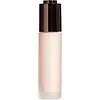Becca Aqua Luminous Perfecting Foundation Versus Rose Inc Skin Enhance Luminous Skin Tint Serum Foundation
What's inside
What's inside
 Key Ingredients
Key Ingredients

 Benefits
Benefits

 Concerns
Concerns

 Ingredients Side-by-side
Ingredients Side-by-side

Water
Skin ConditioningParaffinum Liquidum
EmollientGlycerin
HumectantPetrolatum
EmollientStearic Acid
CleansingGlyceryl Stearate
EmollientSesamum Indicum Seed Oil
EmollientUrea
BufferingLanolin Alcohol
EmollientTriethanolamine
BufferingHordeum Vulgare Extract
EmollientCucumis Sativus Fruit Extract
EmollientHelianthus Annuus Seedcake
AbrasivePropylene Glycol Dicaprate
EmollientSodium Hyaluronate
HumectantButylene Glycol
HumectantPentylene Glycol
Skin ConditioningTrisodium EDTA
Phenoxyethanol
PreservativeCI 15985
Cosmetic ColorantCI 19140
Cosmetic ColorantCI 17200
Cosmetic ColorantWater, Paraffinum Liquidum, Glycerin, Petrolatum, Stearic Acid, Glyceryl Stearate, Sesamum Indicum Seed Oil, Urea, Lanolin Alcohol, Triethanolamine, Hordeum Vulgare Extract, Cucumis Sativus Fruit Extract, Helianthus Annuus Seedcake, Propylene Glycol Dicaprate, Sodium Hyaluronate, Butylene Glycol, Pentylene Glycol, Trisodium EDTA, Phenoxyethanol, CI 15985, CI 19140, CI 17200
Water
Skin ConditioningHexyl Laurate
EmollientGlycerin
HumectantPentylene Glycol
Skin ConditioningOctyldodecanol
EmollientSqualane
EmollientTamarindus Indica Seed Gum
Emulsion StabilisingJasminum Sambac Leaf Cell Extract
MaskingMangostin
Skin ConditioningAcetyl Tetrapeptide-2
Skin ConditioningSodium Hyaluronate
HumectantTocopherol
AntioxidantAlcaligenes Polysaccharides
EmollientDisteardimonium Hectorite
StabilisingAmodimethicone
Carbomer
Emulsion StabilisingMagnesium Chloride
Trisodium Ethylenediamine Disuccinate
Sodium Lauroyl Glutamate
Helianthus Annuus Seed Oil
EmollientPropylene Carbonate
SolventAluminum Hydroxide
EmollientGlucose
HumectantLysine
Skin ConditioningCaprylyl Glycol
EmollientBenzyl Alcohol
PerfumingSodium Hydroxide
BufferingCitric Acid
BufferingMica
Cosmetic ColorantCI 77891
Cosmetic ColorantIron Oxides
Water, Hexyl Laurate, Glycerin, Pentylene Glycol, Octyldodecanol, Squalane, Tamarindus Indica Seed Gum, Jasminum Sambac Leaf Cell Extract, Mangostin, Acetyl Tetrapeptide-2, Sodium Hyaluronate, Tocopherol, Alcaligenes Polysaccharides, Disteardimonium Hectorite, Amodimethicone, Carbomer, Magnesium Chloride, Trisodium Ethylenediamine Disuccinate, Sodium Lauroyl Glutamate, Helianthus Annuus Seed Oil, Propylene Carbonate, Aluminum Hydroxide, Glucose, Lysine, Caprylyl Glycol, Benzyl Alcohol, Sodium Hydroxide, Citric Acid, Mica, CI 77891, Iron Oxides
Alternatives
Ingredients Explained
These ingredients are found in both products.
Ingredients higher up in an ingredient list are typically present in a larger amount.
Glycerin is already naturally found in your skin. It helps moisturize and protect your skin.
A study from 2016 found glycerin to be more effective as a humectant than AHAs and hyaluronic acid.
As a humectant, it helps the skin stay hydrated by pulling moisture to your skin. The low molecular weight of glycerin allows it to pull moisture into the deeper layers of your skin.
Hydrated skin improves your skin barrier; Your skin barrier helps protect against irritants and bacteria.
Glycerin has also been found to have antimicrobial and antiviral properties. Due to these properties, glycerin is often used in wound and burn treatments.
In cosmetics, glycerin is usually derived from plants such as soybean or palm. However, it can also be sourced from animals, such as tallow or animal fat.
This ingredient is organic, colorless, odorless, and non-toxic.
Glycerin is the name for this ingredient in American English. British English uses Glycerol/Glycerine.
Learn more about GlycerinPentylene glycol is typically used within a product to thicken it. It also adds a smooth, soft, and moisturizing feel to the product. It is naturally found in plants such as sugar beets.
The hydrophilic trait of Pentylene Glycol makes it a humectant. As a humectant, Pentylene Glycol helps draw moisture from the air to your skin. This can help keep your skin hydrated.
This property also makes Pentylene Glycol a great texture enhancer. It can also help thicken or stabilize a product.
Pentylene Glycol also acts as a mild preservative and helps to keep a product microbe-free.
Some people may experience mild eye and skin irritation from Pentylene Glycol. We always recommend speaking with a professional about using this ingredient in your routine.
Pentylene Glycol has a low molecular weight and is part of the 1,2-glycol family.
Learn more about Pentylene GlycolSodium Hyaluronate is hyaluronic acid's salt form. It is commonly derived from the sodium salt of hyaluronic acid.
Like hyaluronic acid, it is great at holding water and acts as a humectant. This makes it a great skin hydrating ingredient.
Sodium Hyaluronate is naturally occurring in our bodies and is mostly found in eye fluid and joints.
These are some other common types of Hyaluronic Acid:
Learn more about Sodium HyaluronateWater. It's the most common cosmetic ingredient of all. You'll usually see it at the top of ingredient lists, meaning that it makes up the largest part of the product.
So why is it so popular? Water most often acts as a solvent - this means that it helps dissolve other ingredients into the formulation.
You'll also recognize water as that liquid we all need to stay alive. If you see this, drink a glass of water. Stay hydrated!
Learn more about Water